Solving Rational Equations
In section 2–3 we solved equations that had fractions with
whole numbers for the denominators. In
that section we solved the equations by first using the multiplication property
of equality to multiply
every term in an equation by the Least Common Denominator. When we
multiply each term by
the LCD the resulting equation will not have any fractions in it. We can then
solve this equation by the
methods of chapter 2.
Example
 |
multiply all 3 terms by 10 |
 |
|
 |
subtract 3x from both sides |
| 5x +15 = 0 | subtract 15 from both sides |
 |
( divide both sides by 5) |
| x = –3 |
Solving Rational Equations
All of the Rational Equations in this section will contain terms with
denominators that are contain
polynomials instead of whole numbers.

When we solve the rational equations in this section we
will use the same method as before. We start
by multiplying every term in an equation by the Least Common Denominator.
The difference in
this section is that the LCD will not be a whole number as it was in section
2–3.
 |
 |
| The LCD is 4(x + 2) | The LCD is 6x(x + 4) |
How to solve a Rational Equation
1. Factor each denominator if possible
2. Find the LCD for all the denominators.
3. Multiply every term in the equation by the LCD. Cancel and reduce . This will
leave you with an
equation without fractions .
4. Solve the equation.
5. Check your solution. If the solution makes any of the denominators of the
original rational equation
zero then they cannot be used and there is no solution or

| Example 1 | Example 2 |
| Solve for x | Solve for x |
 |
 |
| the LCD is 6x so mutiply each term of the equation by 6x |
the LCD is 12x so mutiply each term of the equation by 12x |
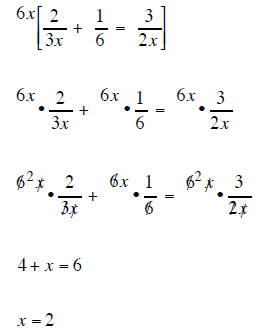 |
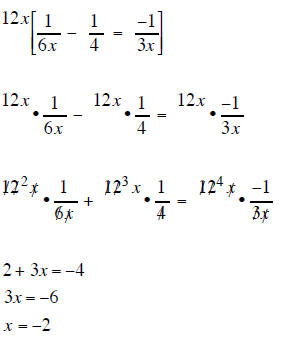 |
| (2 does not cause 0 in denominator so) | (−2 does not cause 0 in denominator so) |
| x = 2 | x = −2 |
| Example 3 | Example 4 |
| Solve for x | Solve for x |
 |
 |
| the LCD is 12x so mutiply each term of the equation by 6x |
the LCD is 12x so mutiply each term of the equation by 12x |
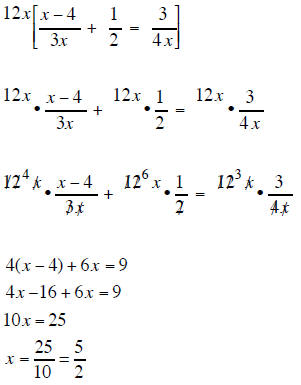 |
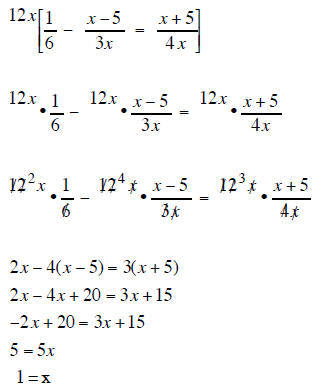 |
| 5/2does not cause 0 in denominator so | 1 does not cause 0 in denominator so |
| x =5/2 | 1 = x |
| Example 5 | Example 6 |
| Solve for x | Solve for x |
 |
 |
| the LCD is (x − 2) so mutiply each term of the equation by (x − 2) |
the LCD is 2x(x − 3) so mutiply each term of the equation by 2x(x − 3) |
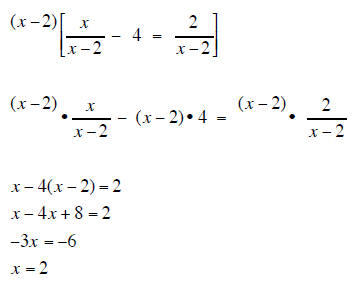 |
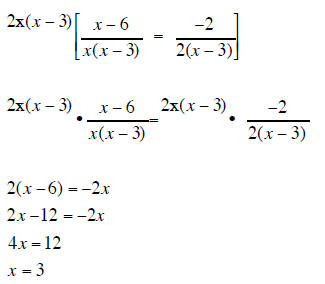 |
| 2 does cause 0 in denominator so | 3 does cause 0 in denominator so |
 or No
Solution or No
Solution |
 or No
Solution or No
Solution |
Example 7
Solve for x


the LCD is (x +1)(x −1) so
mutiply each term of
the equation by (x +1)(x −1)
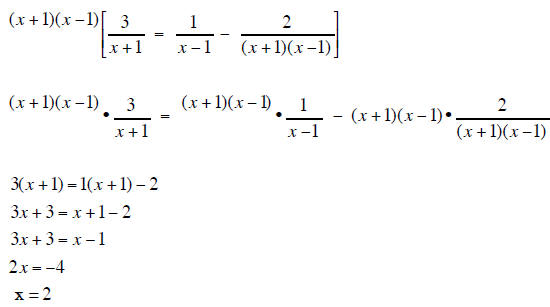
2 does not cause 0 in denominator so
x = 2
Example 8
Solve for x

factor each denominator

the LCD is 6(x − 3) so
mutiply each term of
the equation by 6(x − 3)
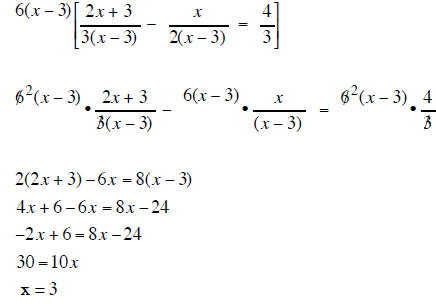
3 does cause 0 in denominator so
 or No Solution
or No Solution
| Prev | Next |